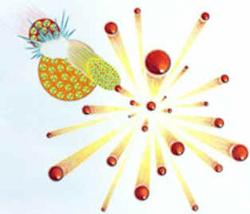The Boiling Point of Quarks

As the temperature and pressure of water changes, it switches among solid, liquid, and gas phases, but similar phase transitions may also occur in more exotic forms of matter, like quark matter. Some models of the nucleus predict that if ordinary protons and neutrons, which are composed of quarks, are squeezed tightly enough at high temperatures, they will turn into a soup of free quarks. This type of phase transition has never been observed, but now the 30 November PRL tells experimenters what signatures to look for to find evidence of it. Researchers are glad to have such clear predictions to aid their search for the transition, whose observation may help answer fundamental questions about quark behavior.
The phase of a sample of matter is determined by variables like its temperature ( T) and pressure ( P) and is often plotted in a P vs. T phase diagram. There is a boundary in this diagram between any two phases, but sometimes there is a point in the phase diagram beyond which the distinctions between two phases of matter become blurred. This point is called the critical end point, and an example is the liquid-gas transition in water at about 374 degrees Celsius and pressures near 218 atmospheres. Moving along the phase boundary, the difference in density between the liquid and the gas decreases until the point where they become identical. So beyond the critical end point, the concept of a phase transition no longer exists. Far from the critical point, density fluctuations are uncorrelated, even over short distances in the sample, but as the critical point is approached, increasingly large chunks of the sample fluctuate wildly as a unit. Similar behavior is common to all phase transitions, and in water the large-scale density fluctuations at the critical point cause it to become opaque.
The end point in the transition between ordinary matter and quark matter is also marked by dramatic changes in physical properties. Misha Stephanov of the State University of New York in Stony Brook and his colleagues have now proposed a way to look for the critical end point of this transition based on the general properties of all phase transitions. One signature of the end point, they say, would be a peak in the specific heat (energy required to change the nuclear temperature) at a particular temperature and density. Another would be a proliferation of low energy pions, which they show to be the quark matter equivalent of the clouding of water at its end point.
Experimentally, the temperature and density of the nucleons is varied by changing the collision energy of nuclei, and these predictions have the advantage of being testable with today’s technology, says Krishna Rajagopal, of the Massachusetts Institute of Technology, and a co-author of the paper. “We are not asking anybody to build a new accelerator,” he says. He notes, however, that not one of the signatures by itself would be an indication of the end point, because they could happen for other reasons.
Frank Wilczek of the Institute for Advanced Study in Princeton, New Jersey, welcomes the work. “The whole nature of the phase diagram is up for grabs,” he says. “They have advanced the subject by putting forward a sharp hypothesis that is testable.” Whether or not a phase transition even exists is not clear, he adds, and the theory will be a crucial guide to any experimental hopes of answering that question.
–Meher Antia
Meher Antia is a freelance science writer.


